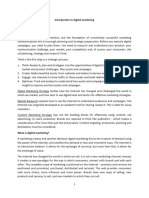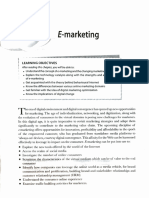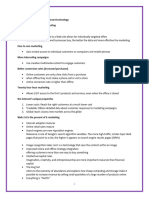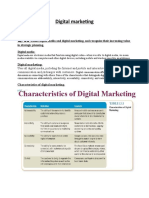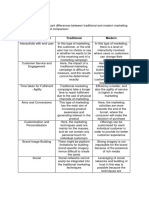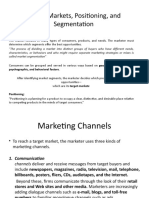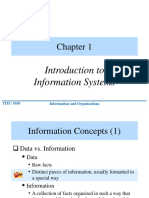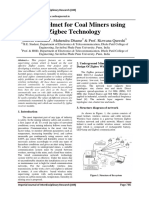0% found this document useful (0 votes)
124 views59 pagesRelationship Marketing
This document summarizes a lecture on formulating marketing strategies in the digital era, specifically for building relationships with customers.
It begins with an overview of opportunities in the app economy and strategic challenges such as whether every company needs a digital strategy. It then discusses threats and opportunities of the digitally networked world for marketers, including the ability to optimize, syndicate information, achieve increasing returns to scale, personalize offerings, and disintermediate distribution channels.
Finally, it proposes a decision framework for developing a digital marketing strategy, covering applications for customer insight, product promotion, transactions, and maintaining customer relationships.
Uploaded by
Mirah AndiCopyright
© © All Rights Reserved
We take content rights seriously. If you suspect this is your content, claim it here.
Available Formats
Download as PPTX, PDF, TXT or read online on Scribd
0% found this document useful (0 votes)
124 views59 pagesRelationship Marketing
This document summarizes a lecture on formulating marketing strategies in the digital era, specifically for building relationships with customers.
It begins with an overview of opportunities in the app economy and strategic challenges such as whether every company needs a digital strategy. It then discusses threats and opportunities of the digitally networked world for marketers, including the ability to optimize, syndicate information, achieve increasing returns to scale, personalize offerings, and disintermediate distribution channels.
Finally, it proposes a decision framework for developing a digital marketing strategy, covering applications for customer insight, product promotion, transactions, and maintaining customer relationships.
Uploaded by
Mirah AndiCopyright
© © All Rights Reserved
We take content rights seriously. If you suspect this is your content, claim it here.
Available Formats
Download as PPTX, PDF, TXT or read online on Scribd
/ 59




